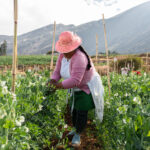California and Florida strawberry acreage reflect market demand

In this installment of the ‘Agronometrics In Charts’ series, Sarah Ilyas studies the state of the strawberry market in the US. Each week the series looks at a different horticultural commodity, focusing on a specific origin or topic visualizing the market factors that are driving change.
California stands out as a year-round producer of strawberries in the US, dominating the market from April to November. In contrast, Florida's harvest season spans from mid-December to mid-May, primarily catering to the winter and spring demands.
According to data from the annual acreage survey conducted by the California Strawberry Commission (CSC), California's strawberry acreage is poised for a 1.4 percent increase in 2024, reaching 40,865 acres. This growth mirrors a consistent upward trend in acreage since 2019, signifying the state's commitment to meeting the demands of both domestic and international markets.
According to the Fruit and Tree Nuts Outlook: March 2024 report published by the USDA, the fall-planted acreage in California, harvested in winter, spring, and summer of 2024, witnessed a notable 4.5 percent increase, totaling 31,221 acres.
The majority of this increase, approximately three quarters, is concentrated in the Watsonville/Salinas region of central California. However, the summer-planted acreage, expected to be harvested in the fall of 2024, is anticipated to experience a slight decline. Moreover, organic production in California is projected to occupy approximately 4,860 acres in 2024, marking an 8 percent decrease from the previous year.
 Source: USDA Market News via Agronometrics.
Source: USDA Market News via Agronometrics.
(Agronometrics users can view this chart with live updates here)
 Source: USDA Market News via Agronometrics.
Source: USDA Market News via Agronometrics.
(Agronometrics users can view this chart with live updates here)
In Florida, the trend is similar, with the state experiencing its fourth consecutive year of increased acreage. The CSC estimates that 15,150 acres of strawberries were planted during the 2023/24 season, with much of the production centered around the Tampa Bay area in Central Florida.
 Source: USDA Market News via Agronometrics.
Source: USDA Market News via Agronometrics.
(Agronometrics users can view this chart with live updates here)
Changes in strawberry shipment volumes, as reflected by USDA data, highlight the dynamics of the market. In the first 10 weeks of 2024, strawberry shipments, including both domestic and imports, increased by 2.2 percent compared to the same period in the previous year. This increase can be attributed to a rise in imports from Mexico and shipments from California, compensating for decreases in volumes from Florida. However, adverse weather conditions in mid-February 2024 temporarily disrupted Florida's shipments, although normalcy was restored by early March.
Conventional strawberry prices averaged $2.48 per kg in week 12, 43% lower compared to 2023. Organic strawberry prices averaged $3.66 per kg in week 12, 12% lower compared to week 12 of 2023.
 Source: USDA Market News via Agronometrics.
Source: USDA Market News via Agronometrics.
(Agronometrics users can view this chart with live updates here
 Source: USDA Market News via Agronometrics.
Source: USDA Market News via Agronometrics.
(Agronometrics users can view this chart with live updates here
The trade dynamics of fresh strawberries reveal interesting trends. In 2023, approximately one-fifth of the fresh strawberries available in the United States were imported, with Mexico being the primary source. Fresh strawberry imports increased by 4 percent year-over-year in volume and saw a corresponding increase in nominal value. Additionally, fresh U.S. strawberry exports witnessed a 4 percent increase in volume, with a notable portion destined for Canada and Mexico.
The strawberry industry in California remains robust, with consistent growth in acreage and production. Despite fluctuations in shipment volumes and pricing dynamics, California continues to play a pivotal role in meeting both domestic and international demands for strawberries, reaffirming its status as a key player in the global market.
 Source: USDA Market News via Agronometrics.
Source: USDA Market News via Agronometrics.
(Agronometrics users can view this chart with live updates here
In our ‘In Charts’ series, we work to tell some of the stories that are moving the industry. Feel free to take a look at the other articles by clicking here.
All pricing for domestic US produce represents the spot market at Shipping Point (i.e. packing house/climate controlled warehouse, etc.). For imported fruit, the pricing data represents the spot market at Port of Entry.
You can keep track of the markets daily through Agronometrics, a data visualization tool built to help the industry make sense of the huge amounts of data that professionals need to access to make informed decisions. If you found the information and the charts from this article useful, feel free to visit us at www.agronometrics.com where you can easily access these same graphs, or explore the other 21 commodities we currently track.














































